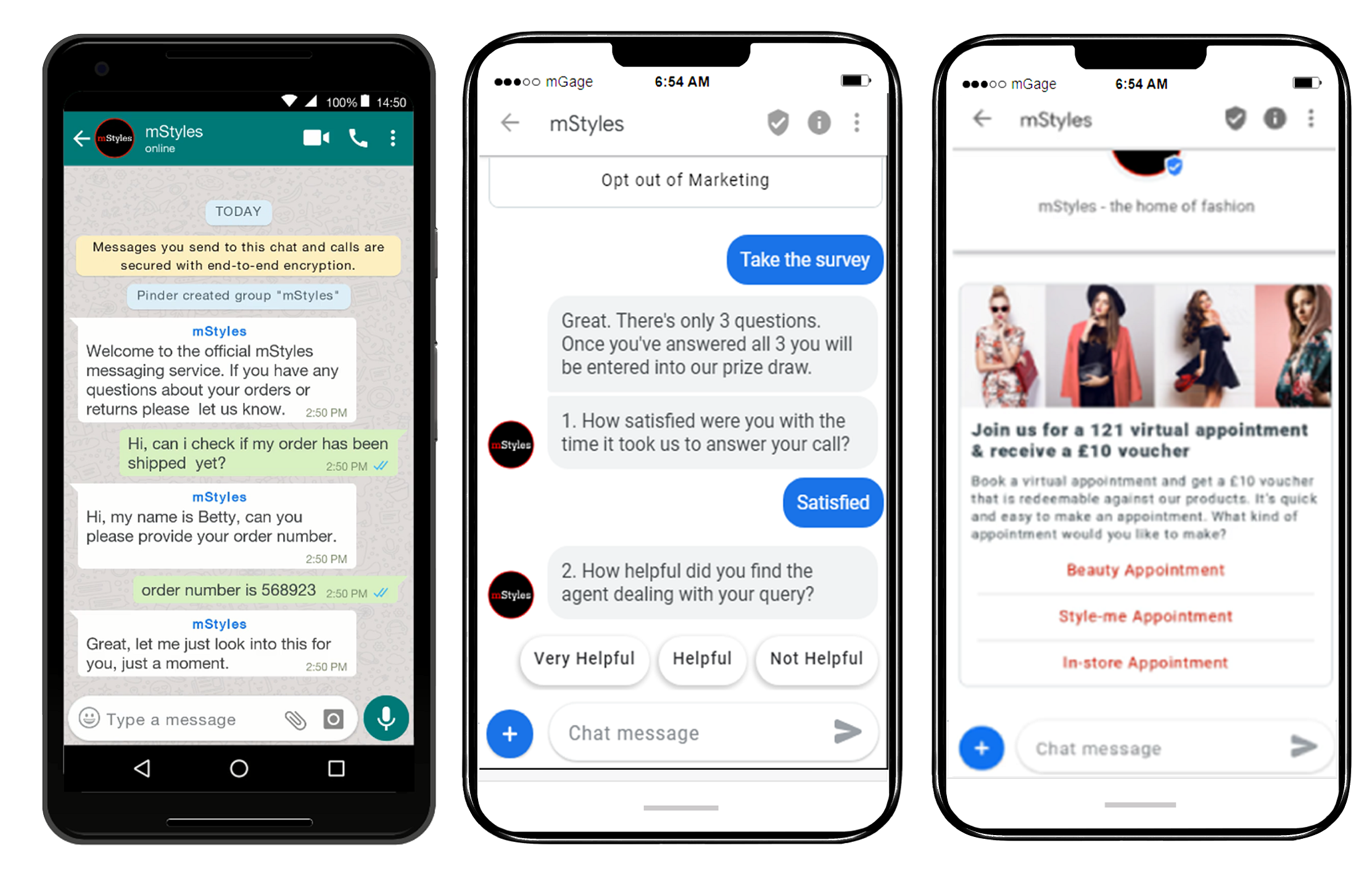Pinder Takhar, Director of Marketing at mGage, offers advice on how to adapt your mobile messaging strategy in line with changing consumer behaviours, many of them heavily influenced by the pandemic.
 2020 was a significant year for business messaging, as we saw an upward trend in its usage. It quickly became an indispensable communication channel for brands to stay connected with their customers, keeping them engaged and informed.
2020 was a significant year for business messaging, as we saw an upward trend in its usage. It quickly became an indispensable communication channel for brands to stay connected with their customers, keeping them engaged and informed.
It also played a key role for customer support, as more businesses started to deploy mobile chat services and automation in line with consumer demands. It proved vital for enterprises to send key and relevant messages to their audience, enabling them to provide a better customer experience.
The sky is the limit
As new mobile technology continues to emerge, along with customer expectations, we believe this appetite for mobile messaging will only grow stronger. People today are using their smartphones heavily every day and are more accustomed to online engagement. This means brands will eventually have to turn to platforms such as Rich Communication Services (RCS), WhatsApp and Apple Business Chat to provide the service their customers will come to expect.
Brands are using SMS now more than ever to communicate with their audience. We have seen the usage increase by 33 to 40 percent since the pandemic. According to Research and Markets, the global A2P messaging market is expected to reach $77.1 Billion by 2026. Therefore, the ability to personalise, initiate a two-way conversation and send timely, relevant messaging makes mobile communication very important to the recipient.
Today’s consumers
Taking our learnings from both business communications and looking at the changes in consumer behaviours, we found that there were three significant areas of change that are likely to stick in 2021 and something all businesses need to think about.
No surprise with this one, but in the last year, there has been a remarkable shift to people shopping online, to the point that eCommerce grew 10-fold in 2020. It’s likely that this change may be for the foreseeable, as sadly, many big and loved brands are disappearing from our high streets and are now run by online giants instead.
Consumers are more cost conscious, so people are buying what they need. This means more essentials and less luxury.
Product discovery went digital, and this will no doubt continue. However, it is important to note that digital product discovery was already happening pre-pandemic. Last year just happened to escalate the trend. This is an opportunity for brands to re-invent the ways in which they interact with consumers and make the discovery phase a lot simpler and smoother.
What should brands consider in 2021?
With consumer behaviours changing, brands should look to re-evaluate their customer experience and communication strategy.
Multichannel approach
Mobile has become a necessity, with consumers now browsing and purchasing via various channels, therefore it is important for brands to be present at these different touchpoints. There are more channels out there like RCS, WhatsApp for Business and Apple Business Chat that brands can deploy to make themselves more available to their customers.
Messaging for Customer Service
Consumers are looking for simple ways to engage with brands, as a YouGov study reported that 69 per cent of consumers prefer communicating with brands over mobile messaging rather than traditional calls. Many businesses have had to adjust over the last year and adopt mobile chat services. However, this is an area that is still largely underutilized for customer support. Enabling different mobile messaging channels offers various routes for your consumers to easily connect with your brand: whether it is to receive product support, request information or to resolve an issue. It enables mobile users to easily initiate a conversation with your brand, and provides a customer-first approach.
Reach: best time to connect
People’s routines have changed significantly, and they are not the same as they were a year ago. Working hours have changed considerably, socialising has shifted online, and many of us are no longer commuting. Before the pandemic, the best times to engage were typical commuting hours and lunch times. However, recent research has shown that there are now spikes around 9am, and after lunch between 2-6pm, with engagement then seeming to decrease until the following day. It’s important to review your data and try different times if you have not already done so.
Convenience and transparency
Make it easier for your customers to engage with you, navigate and find information. Provide clear instructions or guidance, for example if they have ordered an item, as to where they can collect this from. Be transparent by setting expectations. If there will be delays, be open and honest and make it effortless to change appointments or delivery times. Customers today expect fast and timely responses to their enquiries, and a delayed response can often be the basis for a negative review or cancelled service. A report from Forrester Research found that 63 per cent of customers will leave a company after just one poor experience, and almost two-thirds will wait no more than two minutes for assistance.
New avenues to explore
Mobile messaging has huge potential for brands, offering a range of new opportunities for increasing revenue and customer engagement. From simple SMS messages allowing for one time password reminders, verification for mobile banking transactions and confirmation of account changes, to the richer more interactive experiences provided by new innovative channels.
 RCS messaging is the next step up from SMS that allows for an experience like other messaging apps. Features like sender/brand verification, rich media content, suggested response, or action buttons all serve to improve the customer interaction. This tool is seeing an emergence of possibilities, such as enabling your consumers to book virtual appointments, send virtual vouchers and receive order updates. It has also seen a new mobile payments combination that has been deployed by charities to increase donations. Apple Business Chat, Facebook Messenger and WhatsApp also offer enhanced customer service, with chat capabilities that allow your users to initiate a conversation to receive instant support for order queries or delivery updates, as well as sending any feedback. These channels are designed to complement any existing communication strategies you may have, while boosting brand recognition and consumer trust.
RCS messaging is the next step up from SMS that allows for an experience like other messaging apps. Features like sender/brand verification, rich media content, suggested response, or action buttons all serve to improve the customer interaction. This tool is seeing an emergence of possibilities, such as enabling your consumers to book virtual appointments, send virtual vouchers and receive order updates. It has also seen a new mobile payments combination that has been deployed by charities to increase donations. Apple Business Chat, Facebook Messenger and WhatsApp also offer enhanced customer service, with chat capabilities that allow your users to initiate a conversation to receive instant support for order queries or delivery updates, as well as sending any feedback. These channels are designed to complement any existing communication strategies you may have, while boosting brand recognition and consumer trust.
With the recent addition of Verified SMS, this adds that extra layer of protection for both brands and consumers, and is ideal for those types of critical and urgent messages where one-time passwords, PIN verifications or banking alerts may be sent.
There is also the emergence of mobile billing within messaging channels. Today, we already see this incorporated into social channels like Instagram, and believe this will only follow into mobile messaging. It will be made super simple and easy for customers to subscribe to new services or make orders seamlessly, through the click of a button, instead of navigating the payment journey through a different website and/or app.
Looking ahead
As more consumers now expect a better experience from brands, we see mobile messaging playing a crucial role in this. It’s likely during 2021 that more businesses will start to listen and turn their attention to rich messaging, using channels like RCS, Apple Business Chat and WhatsApp alongside their existing SMS platform, as they look to offer a better and enriched customer service.
With the world-first RCS and Payments campaign launched by mGage earlier this month, it’s likely we will see a lot more payment solutions integrated within these messaging channels due to the simplicity and convenience it provides.
To learn more about the emerging new technologies and use cases for mobile messaging, then please get in touch.
















